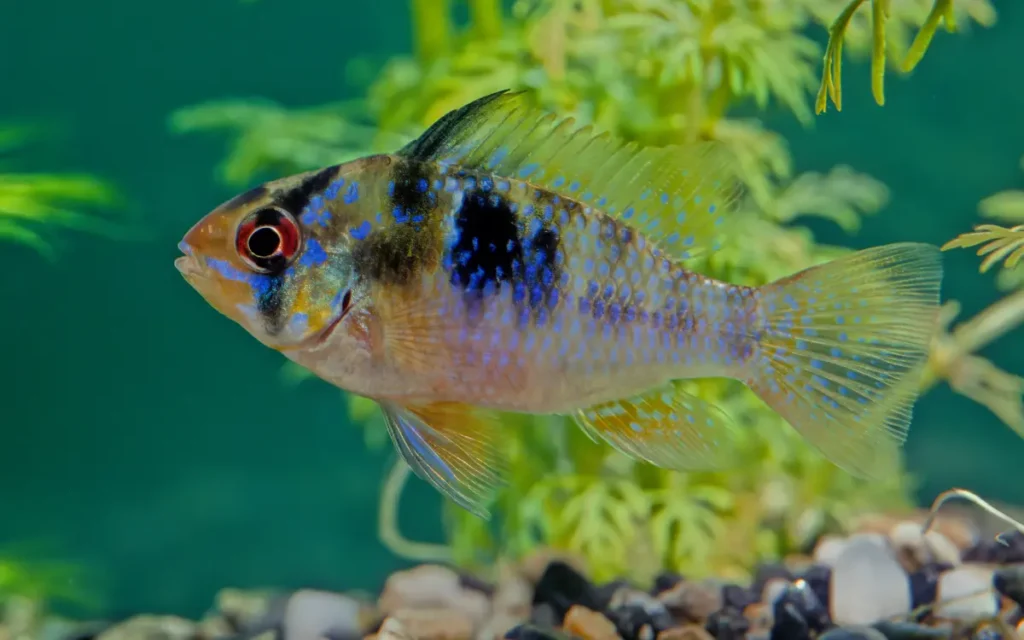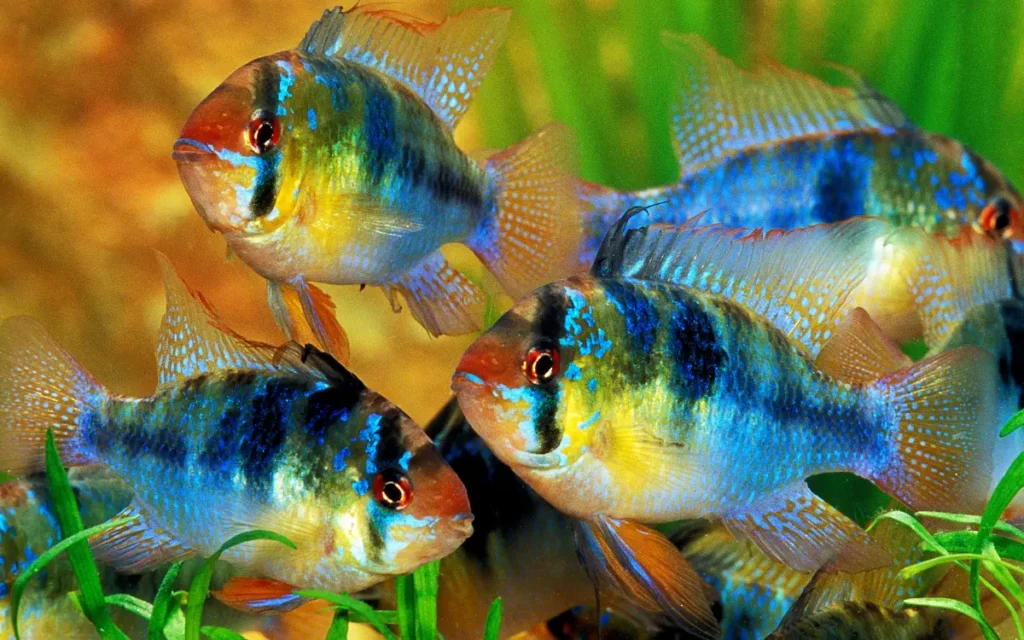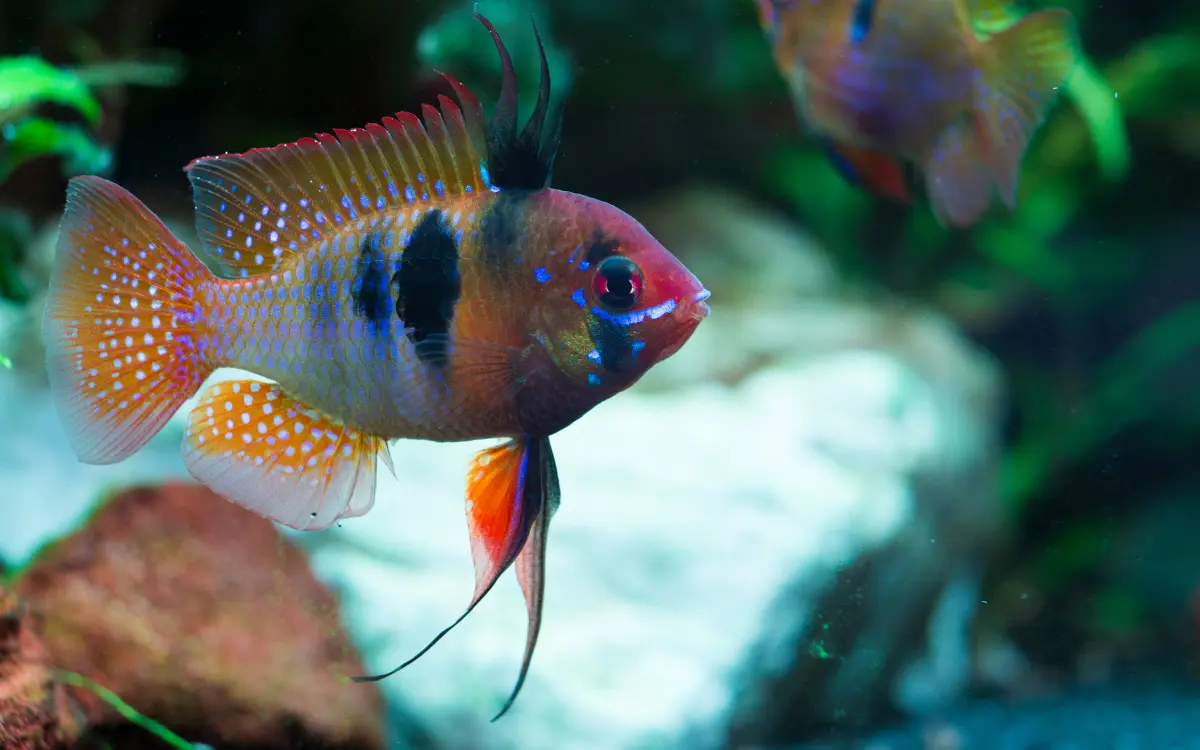The Ram Cichlid, a peaceful fish from the Cichlidae family, is popular among freshwater aquarium enthusiasts for its striking colors and gentle temperament, making it a delightful addition to community tanks.
| Category | Description |
| Family | Cichlidae |
| Aggressiveness | Generally peaceful, but can be territorial especially during breeding |
| Minimum Tank Size | 20 gallons (75.7 liters) |
| Life Span | 2-4 years |
| Diet | Omnivorous: High-quality flake food, pellets, live food, and frozen food |
| Size | 2-3 inches (5-7.5 cm) |
| Compatibility | Compatible with other peaceful fish; avoid larger, aggressive, or fin-nipping species |
| Temperament | Peaceful, social, and active |
Tank Setup for Ram Cichlid

Tank Size
- Minimum Size: 20 gallons (75.7 liters) for a pair of Ram Cichlids.
Water Conditions
- Temperature: 78-85°F (25-29°C)
- pH Level: 5.5-7.0
- Hardness: Soft to moderately hard (1-12 dGH)
Substrate
- Type: Soft, sandy substrate is ideal as it mimics their natural riverbed environment and is gentle on their bodies.
Filtration
- Filter Type: A gentle filter, such as a sponge filter or a canister filter with an adjustable flow, is recommended to maintain clean water without creating strong currents.
Lighting
- Intensity: Moderate lighting to simulate a natural daylight cycle.
- Duration: 8-10 hours per day.
Decor
- Plants: Live plants like Java Fern, Anubias, and Amazon Sword provide hiding spots and reduce stress.
- Rocks and Driftwood: Add smooth rocks and driftwood to create caves and hiding places.
- Leaf Litter: Adding dried leaves can mimic their natural environment and enhance water quality.
Water Changes
- Frequency: Weekly water changes of 25-30% to maintain water quality.
Tank Mates
- Compatibility: Choose peaceful tank mates such as Tetras, Corydoras, and other small, non-aggressive fish.
Feeding Ram Cichlid
Diet Overview
Ram Cichlids are omnivorous, meaning they require a balanced diet of both plant and animal matter.
Types of Food
High-Quality Flake Food
- Purpose: Provides essential nutrients and vitamins.
- Frequency: Daily.
- Example: Tropical fish flakes designed for cichlids.
Pellets
- Purpose: Offers a concentrated source of nutrients.
- Frequency: Daily.
- Example: Sinking pellets suitable for small cichlids.
Live Food
- Purpose: Mimics their natural diet and stimulates natural hunting behavior.
- Frequency: 2-3 times per week.
- Examples: Brine shrimp, daphnia, and bloodworms.
Frozen Food
- Purpose: Provides variety and essential nutrients.
- Frequency: 2-3 times per week.
- Examples: Frozen brine shrimp, bloodworms, and mysis shrimp.
Vegetables
- Purpose: Adds fiber and variety to their diet.
- Frequency: Weekly.
- Examples: Blanched peas, spinach, and zucchini.
Feeding Tips
- Variety: Offer a varied diet to ensure they receive all necessary nutrients.
- Quantity: Feed small amounts that can be consumed within 2-3 minutes to avoid overfeeding and water pollution.
- Frequency: Feed 2-3 times a day in small portions.
- Observation: Monitor their feeding habits to adjust the amount and type of food as needed.
- Supplementation: Occasionally, supplement their diet with vitamins to boost their immune system and coloration.
Breeding Tank Setup

Breeding Tank
- Size: 20 gallons (75.7 liters) or larger.
- Substrate: Fine sand or smooth gravel.
- Plants: Live plants like Java Fern and Anubias to provide hiding spots and create a natural environment.
- Decor: Flat stones or ceramic tiles for egg laying, as well as driftwood and caves for hiding.
Water Conditions
- Temperature: 82-86°F (28-30°C) to encourage breeding.
- pH Level: Slightly acidic, around 5.5-6.5.
- Hardness: Soft water (1-5 dGH).
Filtration
- Type: Sponge filter to provide gentle filtration and prevent fry from being sucked in.
Lighting
- Intensity: Moderate lighting.
- Duration: 10-12 hours per day.
Selecting Breeding Pairs
- Healthy Fish: Choose healthy, vibrant fish free from diseases or deformities.
- Compatibility: Ideally, select pairs that have shown compatibility in a community tank.
Conditioning the Pair
Diet
- High-Protein Foods: Feed a diet rich in live and frozen foods such as brine shrimp, bloodworms, and daphnia.
- Frequency: Feed small amounts multiple times a day to condition the fish.
Water Changes
- Regular Changes: Perform frequent water changes to maintain optimal water quality and simulate natural breeding conditions.
Breeding Behavior
Courtship
- Display: Males will display vibrant colors and perform courtship dances to attract females.
- Cleaning: Pairs will clean a flat surface, like a stone or tile, where the eggs will be laid.
Spawning
- Egg Laying: The female will lay eggs on the prepared surface, and the male will follow to fertilize them.
- Clutch Size: Females can lay 100-300 eggs.
Parental Care
- Guarding: Both parents will guard and fan the eggs to keep them clean and oxygenated.
- Hatching: Eggs typically hatch in 3-5 days.
Raising Fry
Separate Tank
- Transfer: Once the eggs hatch, consider transferring the fry to a separate rearing tank to prevent predation.
- Water Conditions: Maintain similar water conditions as the breeding tank.
Feeding Fry
- First Foods: Feed newly hatched fry infusoria or commercially available liquid fry food.
- Growth Stage: As they grow, introduce baby brine shrimp and finely crushed flakes.
Maintenance
- Water Quality: Perform regular water changes to maintain water quality.
- Observation: Monitor fry growth and health, separating any that show signs of disease.
FAQs
Do Ram Cichlids need sand?
Ram Cichlids prefer a sandy substrate as it mimics their natural habitat and is gentle on their bodies. Sand allows them to exhibit natural behaviors such as sifting through the substrate in search of food.
Can Rams be kept together?
Yes, Ram Cichlids can be kept together. However, it is best to keep them in pairs or small groups to minimize aggression. Ensure that the tank is spacious enough and has plenty of hiding spots to reduce territorial disputes.
Are Ram Cichlids good for beginners?
Ram Cichlids are generally not recommended for beginners due to their sensitivity to water conditions. They require stable and specific water parameters to thrive, making them better suited for more experienced aquarists.
How to tell if a Ram is male or female?
Male Ram Cichlids are typically larger and more colorful than females. Males have longer, more pointed dorsal fins, while females have shorter, rounder fins and a pink or red hue on their belly, especially noticeable during breeding.
What is the maximum size of a Ram Cichlid?
Ram Cichlids can grow up to 2-3 inches (5-7.5 cm) in length. Proper care and optimal water conditions can help them reach their maximum size.
Will Cichlids fight each other?
Cichlids, including Rams, can exhibit territorial and aggressive behaviors, especially during breeding. Providing a well-decorated tank with plenty of hiding spots and maintaining a suitable fish-to-space ratio can help minimize conflicts.

